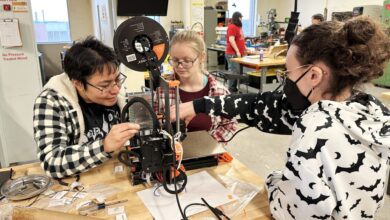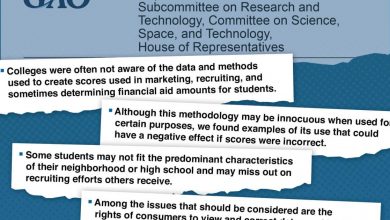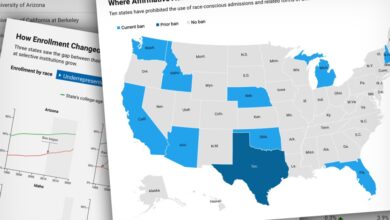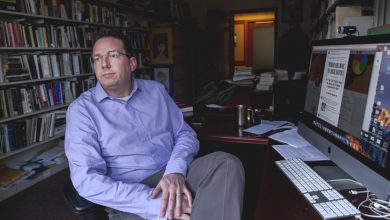What Do Big Tech Layoffs Mean for STEM Programs?

One of the hottest fields for recent college graduates has recently cooled off, as layoffs have hit the technology sector.
On Tuesday, Zoom announced it will be eliminating 15 percent of its staff. Spotify, Amazon, Google, and Microsoft have all made cuts in their work forces in the past month. In November, the Facebook parent company Meta announced it would be cutting 13 percent of its workers. Amazon and Google are also expected to hire fewer interns in 2023 than in past years.
It is being called the largest wave of tech layoffs since the dot-com crash in the early 2000s, and it’s creating headaches for colleges’ career-counseling offices and soon-to-be-graduates who flocked to majors that once promised plentiful jobs.
For the past two decades, colleges, think tanks, and policy makers have touted the wage-earning potential of science, technology, engineering, and mathematics degree programs. Enrollments in many of those fields have grown accordingly, particularly in computer science.
The number of students pursuing bachelor’s degrees in computer and information sciences and support services has increased by 34 percent since 2017, according to data from the National Student Clearinghouse Research Center.
Interest in data science has risen as well. The Bureau of Labor Statistics projects that demand for data scientists will rise by 36 percent, much faster than the average for all occupations, from 2021 to 2031.
If history is any guide, it will most likely take some time for students and undergraduate academic programs to adjust to the changing job market.
The number of undergraduate computer-science degrees conferred in the United States began rising in 1995-96 and continued to do so until just after the dot-com bubble burst in the early 2000s. That started affecting freshmen’s choices. By 2005-6, the number of computer-science degrees as a share of all degrees awarded dropped to 3.2 percent from 3.5 percent in 2000-1. The Great Recession dealt a further blow to the field, as computer-science degrees made up only 2.5 percent of all degrees earned in 2010-11.
Since then, the share of such degrees conferred has grown each year, reaching almost 5 percent in 2019-20.
It’s just a matter of researching the employers that are engaging with the campus, as opposed to pining away for the ones that maybe aren’t at the moment
The drop in enrollment after the dot-com bubble burst was felt on campuses in many ways, said Amruth Kumar, professor of computer science at Ramapo College of New Jersey. Classes that were held once a semester were only held once a year, and some courses were combined in an attempt to fill them up.
Kumar said that he isn’t yet sure what to make of recent tech layoffs. Graduates who are just entering the job market could be disadvantaged by the layoffs and rapid rehiring of tech employees, he said, but the long-term effects on computer science as an academic field remain uncertain.
Besides, computer-science departments may face more immediate threats to their enrollment, and they come from within the campus. Soaring interest in data-science programs could divert institutional resources and draw students. Kumar said that while the increased interest in data science could cause a slight decline in computer-science enrollment, the two areas focus on different ways of problem-solving with technology.
“It seems to me that data science caters to a different skill set than computer science,” said Kumar, who is co-chair of CS 2023, a multi-association effort to create curricular guidelines for computer-science programs across the world.
Kumar believes computer science has become so popular because of the myriad fields computers are now used in.
“It used to be the case that only people use them in STEM disciplines, but now you have computer science being used for communication, social interaction like Facebook and Twitter,” he said. “All these are nothing but computer-science products appealing to other areas, other walks of life.”
Undergrad Programs Forge Ahead
For now, undergraduate programs across the country remain optimistic about interest in their disciplines and students’ job prospects.
The College of William & Mary plans to expand its data-science program; data is one of the four tenets of its “Vision 2026” plan. That’s because data fluency is a skill that students can apply in a variety of industries, said Kathleen Powell, chief career officer at William & Mary.
“Our students are understanding that if they’re combining that data fluency with strong communication skills, strong critical-thinking skills, that is actually opening up pathways for different types of internships and full-time opportunities,” Powell said.
She’s confident most 2023 graduates will find jobs. Companies plan to hire 14.7 percent more graduates from the Class of 2023 than were hired from the Class of 2022, according to a report by the National Association of Colleges and Employers.
For their part, students seem to be optimistic, too. Full career fairs and continued demand from companies that are not tech giants may be giving them a false sense of security amid a possible economic downturn.
“It takes about six months for students to realize that, you know, maybe the job market isn’t as great,” said Gail Cornelius, director of the career center at the University of Washington’s College of Engineering. “It’s also somewhat deceiving in the fact that when we have our career-fair employer activities on campus, we are still full.”
The fairs still attract between 70 and 100 employers, she said, and she hasn’t noticed companies rescinding offers made to students, though some employers have delayed students’ start dates.
Students at Washington have flocked to computer science in recent years. In 2017, the university created a school of computer science, the Paul G. Allen School of Computer Science and Engineering. Since then, the number of undergraduate students enrolled in the university’s computer-science program at its Seattle campus has more than doubled. At the start of the winter quarter in January, the university’s Seattle campus had over 1,500 undergraduate computer-science majors. As of the autumn-2022 quarter, computer science was the most popular major at all three University of Washington campuses.
Many graduates have gone on to jobs at tech companies. About 55 percent of engineering graduates from the university got jobs with large technology companies, said Cornelius, citing data collected by the career center. And 44 percent of graduates found jobs with roughly 500 other companies, including those in nontechnology industries.
“Our students are savvy enough to know that even though I didn’t get the Amazon job, the first job I get out of school isn’t going to be the dream job, and isn’t going to be the place that I die in,” Cornelius said.
Closer to Silicon Valley, career counselors are advising students to be flexible in their career choices.
“There’s always companies and industries that are going to be thriving depending on what the market is,” said Kelly Masegian, a technology and engineering career counselor at San Jose State University. “It’s just a matter of finding those, and figuring out how you can pitch your skills in those environments.”
For example, Masegian and her colleagues are trying to introduce students to technology fields seeing major investments, like the semiconductor industry.
Like Cornelius in Washington, Masegian hasn’t seen job offers to new grads being rescinded, but she has seen some delays. Masegian said about 85 students who received job offers from Amazon had their start date postponed by six months. Many of them are international students, she said, whose ability to remain in the United States hinges on being employed within 90 days of graduating.
Despite the delayed starts for some students, Masegian said, she hasn’t seen companies reducing their hiring. Over 125 employers have signed up for the university’s upcoming STEM career fair, which can accommodate only 80 companies.
“It’s just a matter of researching the employers that are engaging with the campus, as opposed to pining away for the ones that maybe aren’t at the moment,” Masegian said.
She said that some students have been nervous about their ability to get internships, but she tries to remind them of the nature of the internship market. Students vying for internships are not competing with recently laid-off professionals, most of whom have years of experience.
Even recent graduates seeking entry-level positions might not be competing with recently laid-off workers, she said, because of differences in their experience levels.
A Market for M.B.A. Programs
If the changing nature of the tech job market poses a challenge for undergraduate programs, it’s looking like an opportunity for graduate business programs. Some M.B.A. programs are seeking to capitalize on the layoffs, redirecting their recruiting efforts toward unemployed technology workers.
In November, some business schools started waiving fees and testing requirements for applicants to M.B.A. programs who can provide proof of being recently laid off.
For example, the S.C. Johnson Graduate School of Management at Cornell University has waived GMAT or GRE requirements and application fees for laid-off tech workers. The University of California at Berkeley’s Haas School of Business waived its application fee and extended the deadline to apply for its full-time M.B.A. program. Santa Clara University’s Leavey School of Business is waiving application fees and test requirements, as well as promising some prospective students a minimum $3,000 scholarship.
Workers with STEM backgrounds are attractive prospective M.B.A. students because of the skills they’ve picked up in the workplace, said Greg Hanifee, associate dean of degree operations at Northwestern University’s Kellogg School of Management, which announced it was waiving testing requirements in November.
Our students are savvy enough to know that even though I didn’t get the Amazon job, the first job I get out of school isn’t going to be the dream job, and isn’t going to be the place that I die in
Hanifee said Kellogg decided to waive GMAT scores and market to those experiencing tech layoffs out of a sense of empathy for tech workers whose sudden layoffs meant they may not have had much time to study for exams. Kellogg will continue evaluating the economy to determine whether it will waive the exam for next year’s class.
He also said that the high hiring standards of major tech companies, like Meta and Google, mean laid-off workers are strong candidates, even without graduate exam scores supporting their applications.
“I think we’re at the point now where, fingers crossed, the economy rebounds from some of this, and there aren’t additional sectors that go through a similar sort of mass layoff experience,” Hanifee said.
And, while some displaced tech workers may find refuge in an M.B.A. program, many may well be headed right back into the field after earning their graduate degrees. Twenty-four percent of Kellogg’s full-time graduates in 2022 found employment in the technology industry.
The ranks of the newly unemployed may fill a need for M.B.A. programs, said Martin Van Der Werf, director of editorial and education policy at Georgetown University’s Center for Education and the Workforce, and a former Chronicle editor.
Many M.B.A. programs are facing enrollment declines similar to those plaguing institutions across the country. The U.S. is home to over 500 colleges with masters programs accredited by the Association to Advance Collegiate Schools of Business.
Applications for admission to graduate business schools increased only by 0.4 percent from 2020 to 2021, a far cry from the average annual increase of 3.6 percent from 2016 to 2020, according to a report by the Council of Graduate Schools.
The report also says that overall enrollment in graduate business programs declined by 3.4 percent from 2020 to 2021. During that period, part-time enrollment for first-time graduate students fell by 15.6 percent, while full-time enrollment for first-time students rose by 4.1 percent.
“They’re looking to fill as many seats as they can,” said Van Der Werf.
Source link






